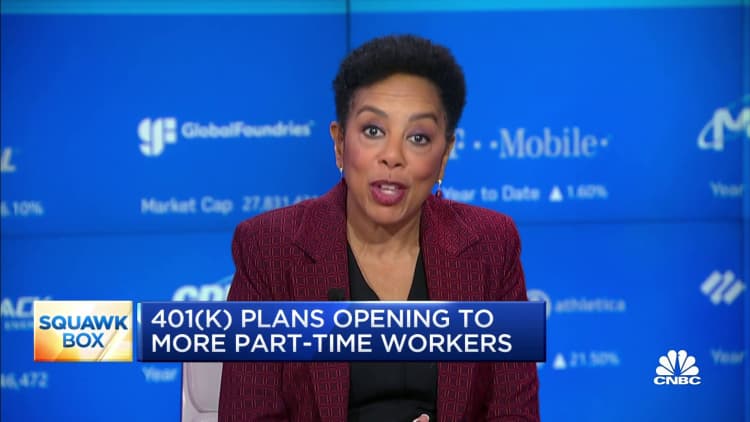Workers who turn 62 years old might be tempted to increase their income by claiming Social Security retirement benefits.
But those claimants should understand that their Social Security benefits may be temporarily reduced due to the income they earn.
That Social Security rule — the retirement earnings test — is "poorly understood by the public," finds a new report from the Social Security Advisory Board, a bipartisan, independent federal agency.
More from Personal Finance:
Even high earners consider themselves 'not rich yet' despite their net worth
The S&P 500 is up about 23% year to date. Here's what to know
Only 60% of student loan borrowers made payments when bills restarted
Between 20% and 50% of pre-retirees do not know that their monthly benefits might be lowered if they continue to work after claiming Social Security, according to the report.
Even for those who are aware their benefits may be reduced, most do not know that reduction is temporary. Just 30% to 40% of beneficiaries know those reductions will eventually be added back to their benefits at their full retirement age, according to the Social Security Advisory Board.
How the retirement earnings test works
The retirement earnings test applies to Social Security retirement beneficiaries who are under full retirement age, which is generally between age 66 or 67 depending on date of birth.
If a beneficiary is under full retirement age and continues to work, they may have their benefits reduced by $1 for every $2 they earn over a certain threshold.
In 2023, the rule applies to income over $21,240. In 2024, that will get pushed up to $22,320.
Notably, the rule is different for the year in which a beneficiary reaches full retirement age, when $1 is deducted for every $3 over a separate limit. In 2023, that applies to earnings over $56,520 only for the months before a beneficiary reaches full retirement age. In 2024, that limit will go up to $59,520.
Why the retirement earnings test is misunderstood
The Social Security Administration's policy calls for its field office staff to discuss the retirement earnings test with all retirement benefit applicants to whom the rule may apply.
However, that does not always happen, according to the Social Security Advisory Board.
Moreover, those conversations also often do not happen with prospective beneficiaries who have stopped working. Since today's workers are more likely to move in and out of the workforce before they fully retire, those beneficiaries may be affected by the rule if they choose to return to work.
The Social Security Administration could also make the information it provides on the retirement earnings test on its website easier to understand and related tools easier to use, according to the report.

Misunderstanding of the retirement earnings test often prompts beneficiaries to delay claiming benefits until full retirement age, according to Emerson Sprick, senior economic analyst at the Bipartisan Policy Center.
"In general, we think that is a good outcome," Sprick said.
Beneficiaries who claim at full retirement age receive 100% of the benefits they earned, while those who claim earlier have their benefits permanently reduced.
"But the fact that that's being done because of a misunderstanding of what the retirement earnings test does, is certainly not a good way to achieve that," he said.
For the vast majority of people who are affected by the retirement earnings test, there is no effect on the amount of their lifetime benefits, Sprick noted.
However, a misunderstanding of the rule's consequences may prompt people to reduce their earned income.
"You see folks who would perhaps work more working less to ensure that their income stays under that threshold," Sprick said.
The Bipartisan Policy Center has advocated for the Social Security Administration to better communicate how it works, as well as possibly eliminate the rule altogether due to the labor disincentives it may create.
Instead of calling the rule a retirement earnings test, the language could be changed to "temporary benefit withholding" to better convey the benefit consequences, Sprick said.
How to avoid a 'real problem situation'
Many financial advisors incorrectly describe the retirement earnings test as a tax and neglect to explain that the benefit reductions will lead to a higher monthly benefit once beneficiaries reach full retirement age, the Social Security Advisory Board report notes.
"Number one, it's not a tax," said Joe Elsasser, a certified financial planner and founder and president of Covisum, a Social Security claiming software company.
"Number two, your benefit is adjusted at full retirement age," he said.
Additionally, as beneficiaries continue to work, they also continue to pay Social Security payroll taxes, which may increase their benefits if that time falls within their highest earning years the program uses to calculate benefits.
Importantly, those beneficiaries need to watch for a "real problem situation" that may arise if they do not properly report their projected wages to the Social Security Administration, Elsasser noted.
That will ultimately catch up to beneficiaries come tax season, when the IRS reports wages to the Social Security Administration.
If they determine benefits have been overpaid, they will withhold benefits until they recoup that sum, prompting an unexpected shortfall for beneficiaries.
"That's the surprise to try to avoid," Elsasser said.


